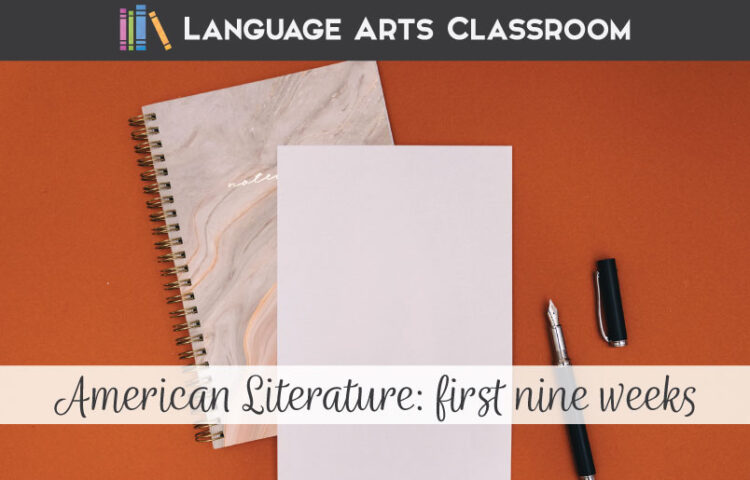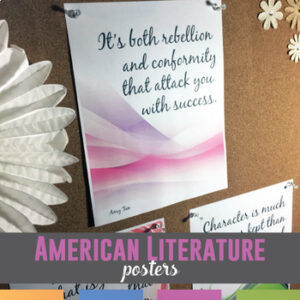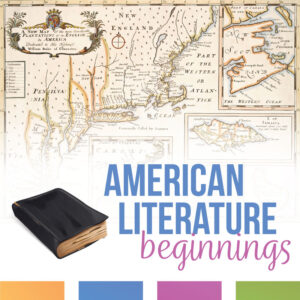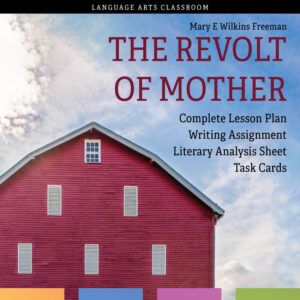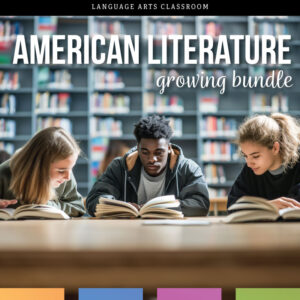foCome along with me as I outline my first nine weeks of American Literature.
The first nine weeks of an American Literature course are a real opportunity.
In my experience, seniors take writing and speech classes for college prep. When junior year covers American stories, we teachers might be delivering many students’ final literature class for life.
This idea shapes my entire development of an American Literature course. While planning the first nine weeks, I consider the tone set about studying stories, engagement for students, and a developing classroom community.
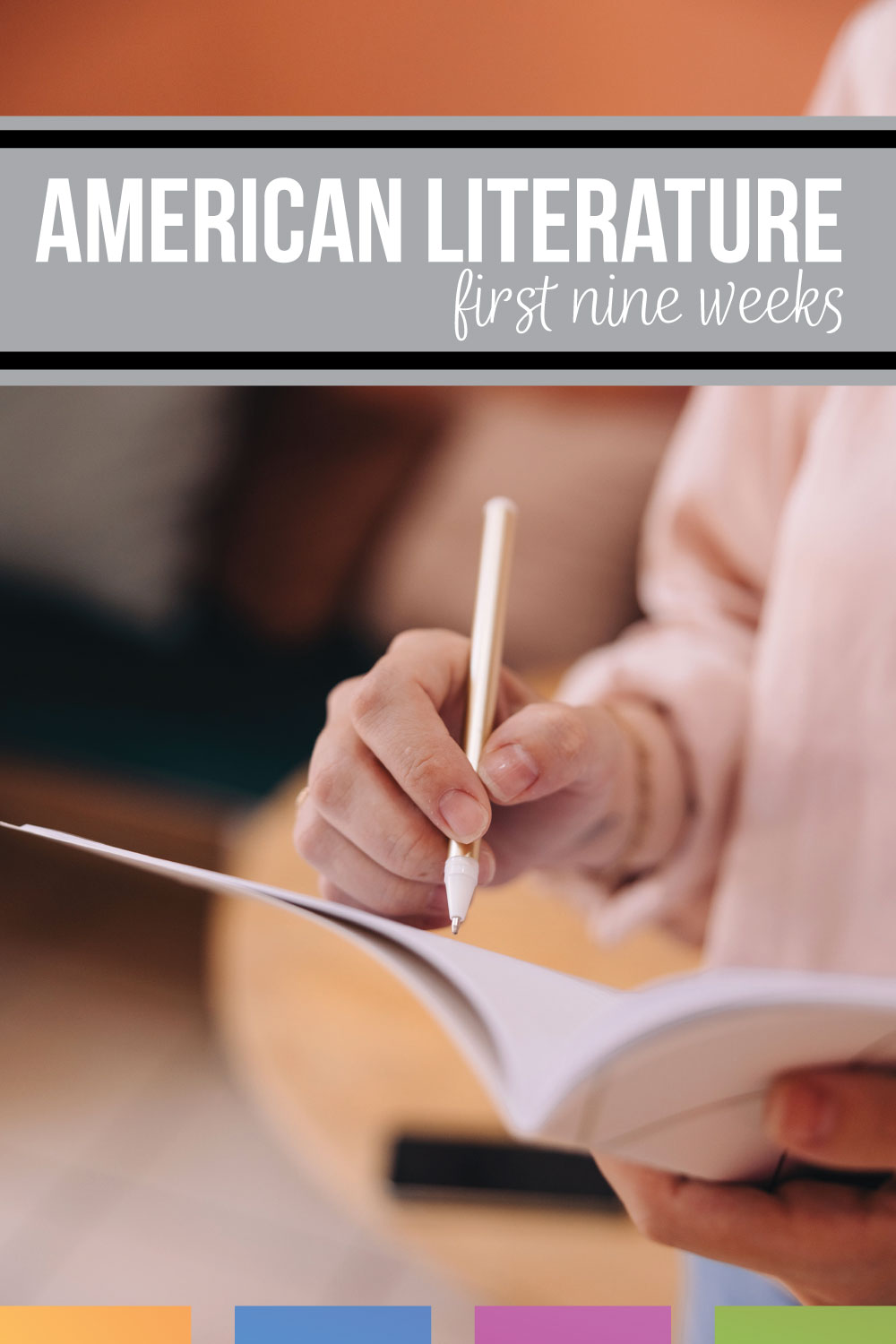
What are your overarching goals for the first nine weeks of American Literature?
At every school I’ve taught, senior year provides dual-credit and elective classes. Junior year might be their last literature course. My largest overarching goal for my American Literature class is to provide stories that my students can relate to which hopefully, in turn, encourages them to read.

Do Now, Bellringers.
As my juniors enter, we will complete bellringers, often called a Do Now activity.
The standards for junior year are tough! Keeping that in mind, students and I work together, tackling those standards in a variety of ways, a variety of times.
Not only do the bellringers start class orderly, but they also present concepts in a bite-sized way. Then, we later build off them. My labels are below, but of course, you can make them your own:
Mentor Monday.
Mentor sentences with pictures encourage connections between new words and prior knowledge. Using pictures to teach grammar and language has worked for me.
Twisted (Spiraled) Tuesday.
Spiral grammar allows teachers to provide review, to introduce new materials, and to circle back on concepts. Students never stop reviewing grammar, and the entire process is less painful than drill and kill is.
My American literature class is taught junior year, and the language standards cover both new topics and the vast prior concepts. Having a designated time helps me to meet those standards.
Writing Wednesday.
Over the past few years, I’ve noticed an uptick in students worried about producing writing. To build writing stamina, we will complete short writing assignments that cover narrative, informative, and argumentative topics.
Together Thursday.
Grammar and writing together. These activities will build off Tuesday and Wednesday. Since my juniors (and their parents) want to prepare for the college entrance exams, we will address commonly covered material.
The beauty? I can tailor this material to fit areas from students’ writing.
Fun Friday.
On Fridays, we will learn about metacognition, the benefits of reading, and read first chapters. Any book works for reading during FCF. We’ll have fun with our classroom library books with book spine poetry and one pagers.
American Literature Units.
My first three American Literature units are generally chronological with modern pieces interspersed. We learn about literary time periods without a heavy focus on designating literature to its time period.
Additionally, we write and read as a community. My goal of forming lifelong readers shapes the class.
Unit One: Where did we begin?
Unit runs approximately weeks one-three.
My goals with the opening unit are three-fold:
One, I want to establish expectations surrounding use of language. One of the standards for language is that language is often contested and frequently changes. To work on this standard and to establish a caring community of learners, I use an excerpt from the introduction to An Indigenous Peoples’ History of the United States for Young People.
Two, I want to teach many American voices. We read “The Earth on Turtle’s Back” (Onondaga tribe of the Iroquois nation); Anne Bradstreet’s “To My Dear and Loving Husband”; an excerpt from Incidents in the Life of a Slave Girl by Harrie Jacobs; “Letter to her Daughter from the New White House” by Abigail Adams; and poetry by Phillis Wheatley.
Third, I want to teach historical elements and terms. We read “The General History of Virginia” and “from Of Plymouth Plantation.” Then, we read and analyze The Declaration of Independence.
Since we are getting to know each other and build a community, flexibility is the key with this first American Literature unit. I have previously taught other popular writings like “Sinners in the Hands of an Angry God” and “Huswifery.” Sometimes, I’ll read those pieces casually with the class.
Finally, with the exception of Dunbar-Ortiz’s book, all of this material is free, in the public domain—bonus!
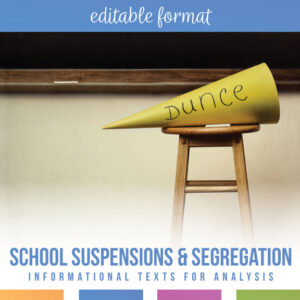
Unit Two: How can we amplify our voices?
Unit runs approximately weeks four-seven.
My classes seems to be engaged at the start of the school year but then, excitement starts to wane, perhaps everyone gets busier. To grab students back into class, I needed a unit that gave students a voice, a unit that focused on their lives. As we dive into the first nine weeks of American literature, we argue about how to improve the school system.
Therefore, our argumentative writing unit is next.
Essential questions focus on:
- What is the purpose of education in the US? Is that purpose met?
- As members of the educational system, how can knowledge concerning issues help?
- In what ways can our voices and stories better the educational system?
First, with all of these essential questions, I tell students that the pronoun “we” is quite purposeful. “We” is all of us in American classroom, and that inclusion means that “we” have different beginnings. For instance, I am comfortable sharing with my classes that even though I work in the school system, I think there are improvements to be made. In American literature, discussing America’s school system is a natural inclusion.
Unit Three: What perspective from the past influence us today?
Unit runs approximately weeks eight-ten.
We close the first nine weeks of American Literature with literary analysis. I use four stories, focus on vocabulary, and dive into the advanced literature standards for high school students. We read:
“The Snow Image: A Childish Miracle” by Nathaniel Hawthorne (1850).
“The Two Offers” by Frances Ellen Watkins Harper (1859).
“The Devil and Tom Walker” by Washington Irving (1824).
“The Revolt of Mother” by Mary E Wilkins Freeman (1890).
Those four stories are from the romanticism and realism time periods. While we do discuss the time period in which stories occur, we primarily focus on literary analysis.
Would you like my editable lesson plans, for free?
Lately, Canva has been my friend for making my lesson plans. Since I have to make them for my classroom, I’ll happily share them with others. Click on each unit below to see the pacing guides:
Unit One. Where did we begin?
Unit Two. How can we amplify our voices?
Unit Three. Whose perspective do we consume?
Please be sure to make a copy so that we can all personalize and edit on our versions. Thank you!
There are affiliate links in this post; please read my disclosures.

